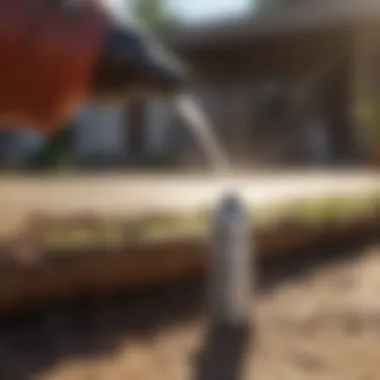Comprehensive Insights on Bifen Ant Spray for Pest Control


Overview of the Topic
Pest control is an essential aspect of agriculture. Among the various solutions available, Bifen Ant Spray stands out. It helps manage ant populations that can damage crops and affect yields. Understanding its components and effectiveness can greatly benefit agricultural professionals and enthusiasts alike.
Definition and Importance
Bifen Ant Spray is a pesticide formulated to target ants specifically. Its active ingredients, primarily bifenthrin, disrupt the nerve functions in insects, leading to paralysis and death. This product is essential in maintaining crop health by managing pest populations. Integrated pest management is crucial, and using effective products like Bifen can leads to better crop outcomes.
Current Trends
The agricultural sector is increasingly moving toward sustainability. Farmers seek solutions that minimize environmental impact while being effective. Bifen Ant Spray fits this trend as it allows targeted control, reducing harm to non-target species. Continuous research into its safety and ecological effects enhances its credibility in the industry.
Key Techniques and Practices
Effective use of Bifen Ant Spray requires understanding its application methods. The following outlines key strategies and tools needed for optimal use.
Step-by-Step Guide
- Identify Infestation: Inspect the areas where ants are most active.
- Prepare the Area: Clear debris and food sources that might attract ants.
- Application: Use the spray according to the manufacturer's instructions for the best results. Make sure to cover all areas where ants are present.
- Monitor: Regularly check the affected areas to assess effectiveness and determine if further applications are needed.
Tools and Equipment Needed
- Protective gear: gloves and masks to ensure safe handling.
- A high-quality sprayer for even distribution.
- Measuring tools to ensure the correct amount is used.
- Containers for storing the spray when not in use.
Challenges and Solutions
While Bifen Ant Spray is effective, there are challenges associated with its use. Addressing these can enhance pest management strategies.
Common Obstacles
- Resistance Development: Over time, pests may develop resistance to active ingredients.
- Environmental Safety: Concerns about the spray affecting non-target organisms.
- Application Errors: Incorrect usage may reduce effectiveness.
Innovative Solutions
- Rotate the use of different insecticides to prevent resistance build-up.
- Employ safe practices to minimize risks to beneficial insects.
- Train users on proper application techniques to enhance efficacy.
Using Bifen Ant Spray responsibly enhances pest control while minimizing environemntal impact.
Prolusion to Bifen Ant Spray
Bifen Ant Spray is an important tool in the realm of pest control. Its effectiveness and versatility make it a go-to solution for many agricultural professionals. Understanding its aspects allows farmers and enthusiasts to make informed choices which can greatly benefit their pest management strategies.
Understanding Pest Control in Agriculture
Pest control in agriculture plays a critical role in ensuring that crops remain healthy and productive. Insects and pests can threaten the yield and quality of agricultural produce. This is where effective pest management strategies come into play. The goal is to minimize damage caused by pests while also protecting beneficial organisms in the ecosystem. Using a product like Bifen Ant Spray can be pivotal in managing ant populations, which are often a precursor to other pest issues.
Considerations in pest control include selecting products that not only target specific pests but also reduce harm to non-target species. Integrated approaches that include cultural, biological, and mechanical controls are essential to maintain sustainable agriculture.
Overview of Bifen Products
Bifen products are distinctly formulated to provide comprehensive pest management. Bifen Ant Spray specifically is prized for its active ingredient, Bifenthrin, which is known for its residual effectiveness. This allows it to control ant populations effectively over time. The formulation is easy to apply and can be utilized in various settings, such as farms, gardens, and around homes.
The broad-spectrum efficacy of Bifen allows for not only the management of ants but also other pests that may associate with them. Farmers can thus use it to offer protection to their crops from a range of threats, contributing to higher yields and less crop loss.
"In pest control, understanding the product specifications can vastly improve your operational success."
Bifen products come in different forms, including sprays and granular formulations, allowing flexibility in application. This adaptability enables users to address pest issues according to their unique environmental conditions and specific pest problems.
Through these details, it becomes evident that Bifen Ant Spray is more than just a pest control solution; it is a critical component in the overarching strategy of agricultural productivity and sustainability.
Chemical Composition of Bifen Ant Spray


Understanding the chemical composition of Bifen Ant Spray is crucial for comprehending its effectiveness and safety profile in pest management. The specific elements within the formulation directly impact its performance against target pests, and their roles can help formulate best practices for application. Assessing both active and inert ingredients provides insight into the overall efficacy, potential risks, and benefits of using Bifen Ant Spray in agricultural settings.
Active Ingredients
Features of Bifenthrin
Bifenthrin is the primary active ingredient in Bifen Ant Spray. This synthetic pyrethroid stands out due to its potent insecticidal properties. One key characteristic is its high effectiveness against a wide range of ant species, making it a popular choice among agricultural professionals. The fast-acting nature of Bifenthrin can quickly reduce pest populations when applied correctly.
A unique feature of Bifenthrin is its residual activity, which allows it to remain effective over time. This characteristic can lead to longer-lasting control, reducing the need for repeated applications. However, this prolonged efficacy also raises concerns about the potential for pest resistance. It's important for users to be aware of this risk and consider integrating Bifenthrin with other methods to manage pest resistance effectively.
Mechanism of Action
The mechanism of action of Bifenthrin primarily involves disrupting the normal functioning of insect nervous systems. It works by binding to sodium channels in the neurons, increasing their excitability. This event ultimately leads to paralysis and death in targeted pests. The key advantage of this mechanism is its rapid lethality, which can provide an immediate solution to pest outbreaks.
However, the action of Bifenthrin does have drawbacks. For instance, the specificity towards terrestrial insects while being harmful to aquatic life must be considered, especially during application near water bodies. Responsible use is therefore critical to mitigate any unintended consequences on non-target species.
Inert Ingredients
Inert ingredients in Bifen Ant Spray, while not biologically active, play essential roles in ensuring product stability and effectiveness. These ingredients can include emulsifiers, solvents, and surfactants that help to distribute the active ingredient evenly and improve penetration into the pest's exoskeleton. Identifying these components can reveal insights into the overall efficacy and user safety of the product. Understanding inert ingredients also aids in assessing potential environmental impacts or allergenic properties that may influence the decisions of agricultural professionals.
The balance and composition of these inert agents can vary between formulations. It is critical for users to thoroughly review product labels and safety data sheets to understand all components before application.
Efficacy of Bifen Ant Spray
Understanding the efficacy of Bifen Ant Spray is crucial for those involved in pest control, especially within agricultural settings. Knowing how well a product performs can directly influence application strategies and overall pest management outcomes. Bifen Ant Spray has gained recognition for its targeted approach to controlling ant populations, which can lead to significant agricultural losses if left unchecked.
Target Pests
Bifen Ant Spray is effective against a wide range of ant species. Its formulation is designed specifically to combat common pests such as:
- Argentine Ants
- Carpenter Ants
- Pavement Ants
- Odorous House Ants
These pests can form colonies that disrupt crop growth and harm structures. The ability of Bifen to target multiple ant species makes it a versatile option for farmers. By focusing on specific pest types, users can tailor their pest management strategies more effectively.
Comparative Effectiveness
When discussing the effectiveness of Bifen Ant Spray, comparing it to other pest control methods can offer further insights. Several aspects come into play here, namely field studies and user reviews.
Field Studies
Field studies play an essential role in evaluating the effectiveness of Bifen Ant Spray. These studies assess how well the product performs under real-world conditions. Key characteristics include:
- Real-World Applicability: Data derived from actual farming environments provides relevant insights into effectiveness.
- Varied Conditions: Field studies account for different weather, soil types, and pest populations, allowing a comprehensive view of effectiveness.
One significant advantage of field studies is their ability to highlight practical usage outcomes, revealing not just efficacy but also the potential limitations of Bifen. For instance, its effectiveness may vary based on environmental factors. These insights are invaluable for farmers looking to integrate Bifen Ant Spray into their practices.
User Reviews
User reviews offer a different yet equally critical perspective on the effectiveness of Bifen Ant Spray. These reviews provide first-hand accounts from farmers and agricultural professionals who have utilized the product. Notable points regarding user reviews include:
- Real Experiences: Actual results from users demonstrate everyday appliacation effectiveness.
- Diverse Perspectives: Feedback can cover different scenarios, helping others understand various outcomes.
A unique feature of user reviews is their capacity to inform potential users about practical challenges and successes. While many users report positive results, there could also be comments on situations where the spray did not perform as expected. This essential information enables farmers to set realistic expectations and enhance their pest management strategies.
"Through careful evaluation of both field studies and user feedback, users can make informed decisions regarding Bifen Ant Spray as a valuable addition to their pest management toolkit."
Application Methods for Bifen Ant Spray
In understanding how to effectively employ Bifen Ant Spray in pest control, the application methods are crucial. Proper application ensures maximum efficacy, safety, and minimal ecological disturbance. Selecting the right method significantly impacts pest control outcomes. Thus, exploring these methods grants farmers deeper insight into how they can integrate Bifen Ant Spray into their practices for improved results.
Preparation of Bifen Ant Spray
Preparation begins with carefully reading the label to follow manufacturer's guidelines. Measured dosage is key. Mixing Bifen Ant Spray with water must be done precisely, as incorrect dilution can affect the product's performance. Using appropriate containers and tools for mixing is essential for achieving the best results. Ensure the mixture is homogenous before application to guarantee even dispersion of the active ingredients.


Application Techniques
Direct Spraying
Direct spraying involves applying Bifen Ant Spray directly onto infested areas. This method is often favored for its simplicity and effectiveness. One key characteristic of direct spraying is its immediate impact on visible pests. Pest control specialists frequently prefer this method as it provides quick results. One unique feature of direct spraying is the ability it provides to target specific infestations, which minimizes waste and maximizes the efficacy of the product. However, the potential disadvantage of this method is that it may not reach insects that are underground or nested in hard-to-reach areas.
Injection Methods
Injection methods offer a targeted approach for applying Bifen Ant Spray, directly introducing the solution into the infestations' habitat. This method is particularly beneficial in addressing pests that are hidden in wood or soil. A notable feature of injection techniques is their capability to provide precise application, ensuring that pests receive the most concentrated dose of the pesticide. The advantage is clear: pests that are not easily accessible through surface spraying can still be treated effectively. However, this method may require specialized equipment and expertise, making it less accessible for every user.
Timing for Application
Timing is an important consideration in the effectiveness of Bifen Ant Spray. Applications should coincide with the life cycle of target pests. Applying during peak activity periods increases contact probability and maximizes results. Additionally, environmental conditions should be considered; for instance, applying early in the morning or late afternoon when temperatures are cooler can enhance performance.
Effective strategies for using Bifen Ant Spray include being aware of both the behavior of target pests and the environmental conditions at the time of application.
Choosing the right application methods is not just about efficacy; it is about adopting a holistic approach to pest management that considers preparation, technique, and timing.
Safety Considerations
Understanding safety considerations related to Bifen Ant Spray is crucial for effective and responsible pest management. The use of any pesticide involves certain risks, both to the applicator and the environment. Ensuring proper safety measures can help mitigate these risks, leading to better outcomes and minimizing adverse effects on non-target species. Notably, safety measures include the use of personal protective equipment, adhering to environmental precautions, and being aware of first aid measures in case of accidental exposure.
Personal Protective Equipment
When applying Bifen Ant Spray, it is essential to use appropriate personal protective equipment (PPE) to safeguard against potential exposure. The recommended PPE may include:
- Chemical-resistant gloves: To protect the skin when handling the product.
- Safety goggles: To prevent splashes from entering the eyes during application.
- Long-sleeved clothing: To cover exposed skin areas.
- Respirators or masks, if necessary, to avoid inhaling spray particles in enclosed spaces.
Following the guidelines on the product label is needed for selecting the right PPE. This practice not only secures the individual applying the pesticide but also contributes to the overall safety of the environment where it is being applied.
Environmental Precautions
Bifen Ant Spray can affect non-target organisms, including beneficial insects, wildlife, and plants if applied indiscriminately. Therefore, it is pertinent to exercise caution during application. Here are a few essential precautions:
- Do not apply near water bodies: Avoid runoff into rivers, lakes, or streams that could harm aquatic life.
- Avoid windy days: Wind can carry spray droplets to unintended areas, increasing the risk of harming beneficial insects or neighboring crops.
- Follow label instructions: The product’s label includes specific guidelines for environmentally safe application.
- Keep away from sensitive areas: Maintain a distance from gardens, beehives, or any areas with wildlife to prevent unintended exposure.
Monitoring the surroundings can help assess risk levels and improve the overall safety of using Bifen Ant Spray.
First Aid Measures
In case of accidental exposure to Bifen Ant Spray, knowing first aid measures can significantly reduce health risks. Here are key actions to take:
- Inhalation: Move the affected person to fresh air immediately. If breathing troubles occur, seek medical attention.
- Skin exposure: Remove contaminated clothing and wash the affected area with soap and water.
- Eye exposure: Rinse the eyes with clean water for at least 15 minutes. Seek medical help if irritation persists.
- Ingestion: Do not induce vomiting unless instructed by a poison control center. Seek medical assistance right away.
Remember to keep the product label and Safety Data Sheet (SDS) accessible for reference during an emergency. This documentation contains essential information for appropriate response procedures.
Overall, implementing these safety considerations is vital to ensure the effective use of Bifen Ant Spray as part of a comprehensive pest management strategy.
Ecological Impacts of Bifen Ant Spray
Understanding the ecological impacts of Bifen Ant Spray is crucial for responsible usage in pest management. As agricultural professionals and enthusiasts, it is vital to consider the broader effects on the ecosystem. The application of pesticides, including Bifen Ant Spray, can have unintended consequences. Therefore, awareness of its impact on non-target species and environmental media, such as soil and water, is essential.
Effects on Non-Target Species
Bifen Ant Spray is designed primarily to target ants, but its active components may affect non-target species as well. Non-target species can include beneficial insects like bees, butterflies, and other insects that contribute to pollination and soil health. The exposure of these organisms to Bifen can result in harmful effects, sometimes leading to a decline in their populations.
Studies show that even low concentrations of Bifenthrin, the active ingredient in Bifen Ant Spray, can impact the behavior and physiology of non-target insects. For example, bees, which are critical for pollination, may be affected when they come into contact with treated surfaces or residues. Therefore, it is critical to assess application methods and timing to minimize risks to these species.
- Key Considerations:
- Minimize sprays during flowering periods to protect pollinators.
- Be mindful of drift and runoff during application.
- Opt for targeted application techniques when possible.


Soil and Water Impact
The effects of Bifen Ant Spray extend to soil and water quality. Bifenthrin can persist in the environment, leading to concerns about soil contamination and water availability. When applied, residues may leach into the soil, affecting microorganisms that play a vital role in nutrient cycling. This disruption can lead to a decrease in soil health and agricultural productivity.
In addition, runoff from treated areas can contaminate nearby streams, rivers, and lakes. Aquatic ecosystems can become affected by pesticide runoff, leading to potential harm to fish and other aquatic organisms. Understanding these potential impacts is essential for making informed decisions about pest management strategies.
- Impacts on Soil and Water:
- Changes in soil microbial diversity.
- Potential toxicity to aquatic life.
- Accumulation of pesticides in water resources.
In summary, the ecological implications of using Bifen Ant Spray cannot be overlooked. As agriculture moves toward more sustainable practices, understanding these impacts will guide the development of integrated pest management strategies. By recognizing the interconnectedness of all these elements, agricultural professionals can create systems that not only address pest issues but also promote environmental health.
Integrating Bifen Ant Spray into Pest Management Strategies
Integrating Bifen Ant Spray into comprehensive pest management strategies is vital for effective and sustainable agricultural practices. Pest management is a dynamic field, requiring professionals to use various methods in combination to enhance efficacy and minimize negative impacts. This section explores how Bifen Ant Spray can fit into broader pest management plans, addressing benefits and considerations that should be considered.
Understanding Integrated Pest Management
Integrated Pest Management, or IPM, combines different strategies to control pests effectively while minimizing risks to humans, non-target organisms, and the environment. The essential feature of IPM is its holistic approach, integrating biological, cultural, physical, and chemical controls. Bifen Ant Spray acts as a crucial component within IPM, particularly for ants and other pests that threaten crops.
Key aspects of understanding IPM include:
- Assessment: Accurate identification of the pest is crucial. Knowing the target pest helps determine the best control methods.
- Monitoring: Regular monitoring is essential to evaluate pest populations and the effectiveness of the management strategy.
- Decision-Making: IPM relies on decision-making thresholds to determine when treatments are needed, weighing the risk of the pest versus the cost of action.
Bifen offers a quick-response solution that fits well into IPM strategies. Its effectiveness allows farmers to address pest outbreaks promptly, protecting their crops without heavily relying on chemical treatments.
Complementary Practices
Complementary practices enhance the effectiveness of Bifen Ant Spray in the pest management strategy. Understanding these practices can contribute to sustainable and effective pest control. They can be categorized into biological control and cultural practices, both essential in IPM.
Biological Control
Biological control involves using natural predators or pathogens to manage pest populations. This method is beneficial for several reasons:
- Natural Regulation: Beneficial insects, such as ladybugs and parasitic wasps, can significantly reduce pest populations without toxic chemicals.
- Sustainability: Biological control reduces the need for chemical pesticides, making farming more sustainable in the long run.
- Reduced Resistance: Using natural predators can decrease the likelihood of target pests developing resistance to chemical controls, including Bifen.
A unique feature of biological control is its long-term effectiveness compared to short-term chemical treatments. However, it requires knowledge of local ecosystems and may take longer to see results.
Cultural Practices
Cultural practices refer to farming methods that minimize pest presence or improve crop resilience. They include crop rotation, intercropping, and sanitation measures:
- Diversity: Crop rotation disrupts pest life cycles, potentially reducing the reliance on chemical controls like Bifen.
- Sanitation: Keeping fields clean of debris helps prevent pest infestations, reducing the need for interventions.
- Timing and Variety: Selecting pest-resistant plant varieties and planting at optimal times can mitigate pest issues before they arise.
The unique aspect of cultural practices is their low cost and ease of implementation. However, they often require careful planning and documentation to assess effectiveness.
The End and Future Considerations
Bifen Ant Spray represents a significant advancement in pest control strategies, particularly for those in agriculture. As we conclude this article, it is essential to revisit the role of Bifen Ant Spray within a broader framework of pest management. Understanding this not only enhances its effective use but also informs future developments in pest control products.
Revisiting the Role of Bifen Ant Spray
Bifen Ant Spray, primarily composed of Bifenthrin, serves as a formidable tool against various ant species. Its effectiveness lies in its unique mechanism of action, which targets the nervous system of pests, producing quick results. This quick knockdown effect is crucial for farmers facing sudden infestations.
However, using Bifen Ant Spray is just one piece in the intricate puzzle of pest control. Over-reliance on any single product can lead to resistance challenges. Therefore, revisiting its role encourages farmers to integrate it thoughtfully into their pest management systems. They should consider rotating Bifen Ant Spray with other solutions to manage pest populations effectively over time.
Sustainable Pest Management for the Future
As we look toward the future of agriculture, sustainable practices must take center stage. Pest management practices that prioritize environmental health are paramount. Bifen Ant Spray can complement these practices if used judiciously and in conjunction with integrated pest management strategies.
Emphasizing sustainable approaches includes:
- Diverse Crop Rotation: This can disrupt pest life cycles and reduce reliance on chemical solutions.
- Biological Control: Utilizing natural predators can keep pest populations in check without chemicals.
- Cultural Practices: Simple changes, like altering watering techniques or soil health management, can create an environment less conducive to pest infestations.
Farmers must be proactive in adopting such methods alongside Bifen Ant Spray. Implementing comprehensive pest management strategies ensures both effective pest control and long-term ecological balance. The path forward requires a balanced approach, combining effective products with sustainable practices to protect crops and promote environmental health.
"Integrating Bifen Ant Spray effectively can yield immediate results, but sustainable practices ensure future success in pest management."
In summary, while Bifen Ant Spray plays a vital role in pest control, it is critical for agricultural professionals to approach pest management holistically, fostering sustainable practices that can mitigate future challenges. The commitment to responsible use of pest control methods will not only benefit today’s agricultural landscape but also preserve it for future generations.



